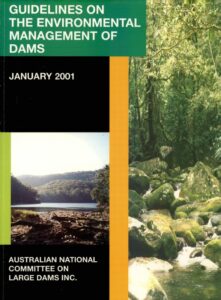- Home
- Resources & Information
-
-
Resources & Information
-
Member Resources
- ICOLD Website Login
- ICOLD Circulars
-
-
- News & Events
- Membership
-
-
ANCOLD Membership
-
-
-
- About Us
 The Guidelines on the Environmental Management of Dams have been prepared for ANCOLD members and others interested in the management of dams. They define ANCOLD’s position on the need to integrate environmental and social considerations into the planning, design, and maintenance and management of large dams.
The Guidelines on the Environmental Management of Dams have been prepared for ANCOLD members and others interested in the management of dams. They define ANCOLD’s position on the need to integrate environmental and social considerations into the planning, design, and maintenance and management of large dams.
They are supportive of the lead taken by the International Commission on Large Dams (ICOLD), when in November 1995, in a Position Paper on Dams and Environment, the Commission declared “ICOLD attaches great importance to the environmental and social aspects of dams, and want them to be addressed with the same concern which has made the question of dam safety a predominant concept pervading all its work. ” (ICOLD, 1995a)
Accordingly the guidelines are presented within a strong sustainability framework. Also in keeping with other ANCOLD guidelines, a risk management framework is used to present the important environmental impact assessment (EIA) process.
The Australian policy and legislative framework is the basis of the guidelines. However, it is recognised that the Australian dam industry is increasingly looking for opportunities to provide the expertise it has developed to the countries of Asia and on occasions, those further afield. It is expected that the application of these guidelines will be universal, applied equally within Australia and overseas where ever members practise. In the overseas context members should apply these guidelines in the context of ICOLD Position Papers. They will also need to reconcile differences in social and economic conditions in the interpretation of some aspects of the guidelines.
Finally, the World Commission on Dams (WCD) released its findings on 16 November 2000. The findings and recommendations are a landmark in this industry, likely to have far reaching effects for both new and existing projects. The decision to finalise and release the ANCOLD Environmental Guidelines prior to members being able to consider the WCD findings means that subsequent changes to these guidelines are inevitable. Notwithstanding, it was considered that there was merit in having both documents available to facilitate discussion. It is a strong recommendation of the WCD that the industry moves quickly to embrace their recommendations in the form of local guidelines.
In 2014, Regulation and Practice for the Environmental Management of Dams in Australia was prepared by ANCOLD as a companion to the 2001 ANCOLD Guidelines on the Environmental Management of Dams. Since the 2001 guidelines were published much has been learnt about the critical issues that drive environmental concerns for both dam practitioners and the broader community arising from the construction of new dams, dam upgrades or altered operational strategies. The objective of the 2014 companion volume to the 2001 Environmental Guideline is to increase environmental awareness by encouraging more sustainable planning, design, construction and operation inputs to large dams. As such the companion volume complements rather than replaces the existing 2001 guideline.
The 2014 companion volume focuses on:
$104.00

ANCOLD is an incorporated voluntary association of organisations and individual professionals with an interest in dams in Australia.